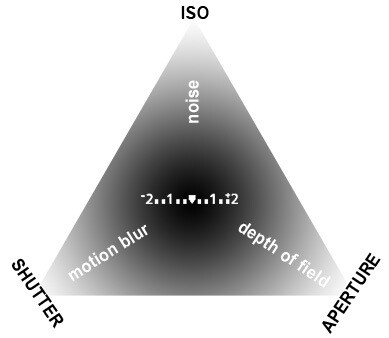"Lets start of by defining exposure:
"is the total amount of light allowed to fall on the photographic medium during the process of taking a photograph” (Wikipedia)."
Whether it is a digital sensor chip or grains of chemically dosed silver on a film, it is the same thing. The greater the amount of light that falls onto a particular region of the photographic medium, the brighter that part of the recorded image will be when reproduced, whether on screen, print or slide.
This applies to all types of mediums (digital and film). Pretty much what it means is that teh greater the amount of light that falls onto a specific region of the medium, the brighter that part of the medium will get (which renders the image).In the camera world brightness is measure in EV or also knows as Exposure Value.
Brightness is measured in “Exposure Value” or EV.
The EV or the "Stops"Changing your EV by one on your camera is called a "stop" if you didn't know that.
You often hear photographer talking about the light and exposure in a photograph, from the begging i had no idea what the they meant (i was thinking shutter speed or EV only) but thats not what it means actually, exposure is a summer of the exposure triangle (ISO, shutter speed and aperture) as you will see below. I must say as i said before that one of the most important things that you can do as a photographer is get a good feeling about the light or light levels if you will. To understand the intensity of the light your working with
This doesn't mean you should just walk outside and think "ohh for the perfect shot i will be needing a EV of -0.7 a shutter speed of 1/125 and a aperture of f/4" but there are some fellas out there that can do this, but why bother when you a exposure meter in your camera. But on the other side if you learn to look at a photo that you have taken and you notice that the exposure needed for that shot has to be decreased by lets say 1/3 stop, then you will get a very good idea of whats going and you will see whats going on.
So how do i control exposure?
To accommodate the huge variety of brightness levels we see in the real world, we need to be able to control how much light gets to the camera’s sensor. We do this by adjusting one or more of the three points of the “exposure triangle”. These three points are ISO, Shutter and Aperture.
The aperture is an adjustable iris or opening that can be made wider to let in more light, or narrower to let in less. The shutter is the “gate” that allows light onto the sensor, and it can be left open for different lengths of time, to let the sensor collect more or less light. Finally, the ISO once referred to the sensitive to light of the film in the camera. In digital cameras it refers to the “gain”, or amplification of the information collected by the sensor. In film days, changing ISO meant changing films. Today the ISO can be easily adjusted with a dial.

Each of these points will be the subject of future lessons in Photography 101. For now, you need to know that they are there, and that they all work together to control the exposure. At the centre of the exposure triangle is your camera’s light meter. It is by reading this that you determine how to set each of the three points. We’ll cover that in a future lesson as well, probably in Photography 102 - A Basic Course in Taking Photos.
Trade-Offs
Each method of controlling exposure does so in a different way, and as such, has a different effect on the character of the resulting photo. Increasing the shutter speed reduces the light, and freezes motion. Decreasing it allow more light in, but blurs movement occurring while the shutter is open. Closing the aperture decreases the light, but increases the depth of field, meaning sharp focus over more of the image. Opening the aperture lets in more light, but decreases the depth of field, meaning a narrower window of sharp focus. Increasing the ISO amplifies the light collected, but also amplifies the random noise in the chip, which can become visible in photos at higher settings.
It’s important to note that all of these effects can be used for creative purposes in photography. Having a narrower depth of field for example can be an artistic effect in a portrait, a slower shutter speed can convey a feeling of movement. Taking a good photo is the result of the conscious choice of the three points on the exposure triangle in order to get a well exposed image which has a character pleasing to the photographer. Adjusting the settings is a balancing act that affords huge creative options to the photographer." Original post from DPS

No comments:
Post a Comment